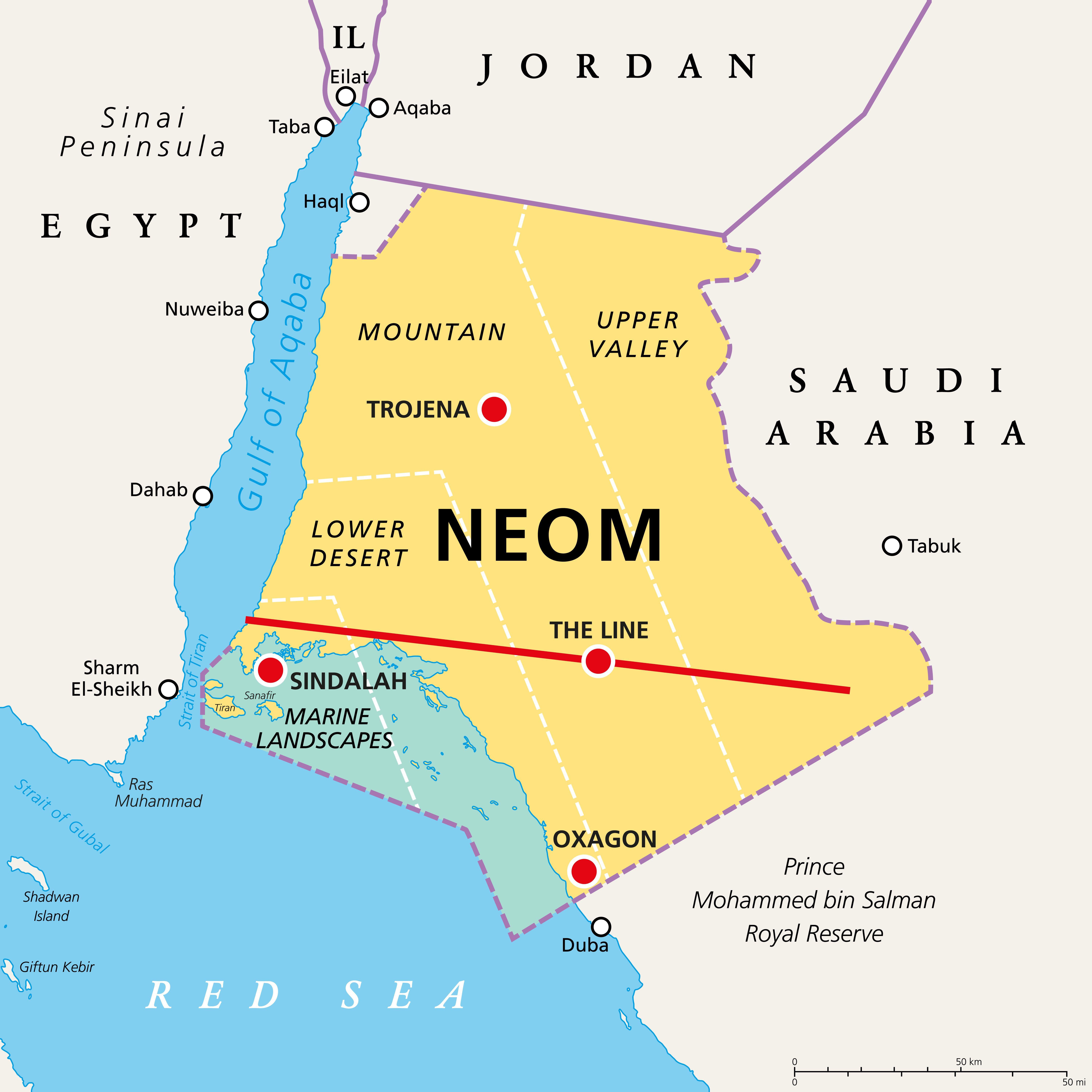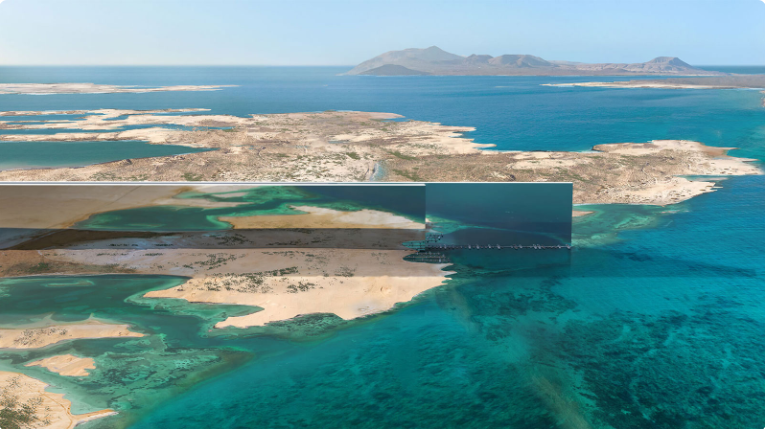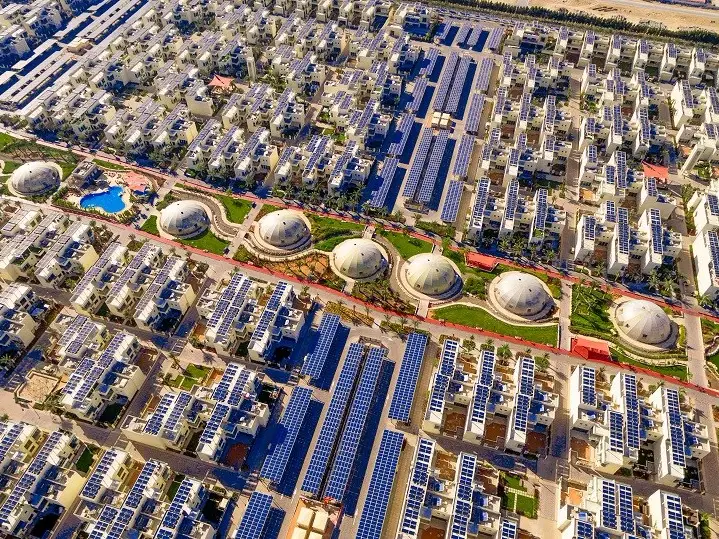The NEOM Project in UAE: Everything to Know About This Futuristic City (2025)
Table of Contents
“The best way to predict the future is to create it,” said Abraham Lincoln.
In saying that, he quoted the most fundamental attribute of mankind, which is, to interpret, plan, and prepare for “what’s next?” As a species, humans are wired to navigate the world’s uncertainties by putting their cognitive abilities to use. This not only ensures our survival, but also fulfils our desire for growth, excellence, and supremacy. In our pursuit of making tomorrow better, we continuously strive to identify how the environment is changing and what best we can do to adapt to it. The NEOM project is one such sustainable development initiative that aims to create future-relevant built environments that are both healthier and happier.
What is NEOM Project?

The term NEOM is a fusion word coined by His Royal Highness Mohammed bin Salman, Crown Prince and Chairman of the NEOM Company Board of Directors. The first three letters of “NEO” are derived from the Ancient Greek prefix- neo, meaning “new”. The fourth letter “M” is brought in from the Arabic word “Mustaqbal”, which means “future”. When put together, the term NEOM means “a new future”.
At its core, NEOM is a vision that aims to build the future, today. The identified project site is a region in the northwest Kingdom of Saudi Arabia in the Tabuk Province, with the Red Sea to its south. Through NEOM, the intent is to address the prevailing challenges of life on earth through technology-led, people-centric, nature-inspired, and sustainable solutions. Titled “the land of the future”, NEOM seeks to redefine the life quality of people by providing built environments that foster progress, curiosity, and sustainability.
Read more: Exploring the 8 Most Innovative BIM Projects in the Middle East
Statistical Overview of the NEOM Project 
The NEOM project is a part of Saudi Arabia’s Vision 2030 which plans to diversify the country’s economy in an attempt to reduce its dependency on oil. The regional development of NEOM is bifurcated into 5 key projects namely, the Gulf of Aqaba, Oxagon, Sindalah, the Line, and Trojena. Within the Gulf of Aqaba exists 10 projects, namely Leyja, Epicon, Seranna, Utamo, Norlana, Aquellum, Zardun, Xaynor, Elanan, and Gidori.
The site encompasses an area of about 10,200 square miles (26,500 square kilometres). USD 500 billion is directed towards the project from the Public Investment Fund of the Kingdom of Saudi Arabia in association with local and international investors. NEOM aspires to become a diversity-rich community, powered by talent, across the 14 sectors of:
- Manufacturing
- Water
- Digitalisation and technology
- Entertainment and culture
- Education, research, and innovation
- Design and construction
- Food
- Energy
- Sport
- Tourism
- Mobility
- Health, well-being, and biotech
- Financial services
- Media
Project History and Timeline

The NEOM is a futuristic city and a mega-project attempting to redefine the future of life on Earth. The table below encapsulates the inception and progress of this futuristic city project.
|
Year, Month |
Key Project Milestones |
|
2017, July |
Announcement of NEOM project |
|
2018, April |
Formation of NEOM Bay Airport Company |
|
2018, October |
Inauguration of The Line |
|
2019, April |
Launch of NEOM's "THE LINE" project plan |
|
2020, June |
NEOM's first wind turbine installation |
|
2021, September |
NEOM's first phase of development begins |
|
2022, December |
Completion of NEOM's first residential area |
|
2023, August |
Opening of NEOM's first university campus |
|
2024, March* |
Launch of NEOM's sustainable transportation system |
|
2025, December* |
Completion of NEOM's first phase of construction |
|
2026, June* |
NEOM's first fully operational smart city area |
*The project timeline may be variable based on unforeseen circumstances.
Read more: How Was Computational Design Used to Construct the Louvre Abu Dhabi?
7 Key Projects within the NEOM Initiative
The NEOM project is a vision achieved through multiple small and large-scale projects. Below is an insight into all the projects launched thus far under the label of NEOM.
1. The Line

Launched in 2021, The Line is a one-of-its-kind urban design project conceptualising a high-density linear vertical city development. The project is fundamentally envisioned to create a community-centric city offering world-class urban living. A central park runs through the Line serving as a green corridor, connecting various neighbourhoods and providing easy access to nature. Pedestrian-friendly pathways, well-planned public spaces, and thoughtful landscaping contribute to the overall urban living experience.
Abating pollution and making provision for clean air is one of the key goals of The Line. Therefore, sustainable transportation solutions, such as dedicated bike lanes, electric vehicle charging stations, and efficient public transportation networks, are seamlessly integrated into the plan. This sustainable development project also has integrated technologies that further enhance transportation efficiency, providing real-time information and optimising traffic flow within the linear park.
Green building practices are incorporated into projects through energy-efficient designs, green roofs, and innovative materials that minimise environmental impact. This will also help establish a comfortable microclimate within the city. The project places a strong emphasis on resource management, utilising rainwater harvesting systems to mitigate water usage and employing renewable energy sources to power public spaces. Further, the project aims to foster a business-conducive environment.
2. Oxagon

The Oxagon is a greenfield project announced in 2021 as a project reimagining the idea of an industrial city. It is dedicated to constructing a tech-advanced, clean, and healthy ecosystem for business, aligning with the principles of Industry 4.0 and circularity. The Oxagon aligns with NEOM's overarching mission of creating a cutting-edge model for entrepreneurship, functioning as a living laboratory for an international community of visionaries. The key architectural features of Oxagon include a next-gen port with an integrated supply chain, 100% powered by renewable energy, a dedicated research and innovation campus, and access to best-in-class resources.
3. Sindalah

With its inception in 2022, Sindalah is heralded as NEOM's premier luxury island and yacht club destination in the Red Sea. It embodies a visionary paradigm for sustainable living, aiming to redefine the boundaries of experiential luxury. The project masterplan envisions a symbiotic relationship with nature, leveraging its pristine surroundings to create an environment that seamlessly blends opulence and ecological consciousness. Anticipated to generate 3,500 jobs across the tourism, hospitality, and leisure sectors, the development promises a boost to the regional economy. This economic infusion aligns with NEOM's broader mission of fostering sustainable growth and progress.
4. Trojena

Trojena, nestled within the mountains of NEOM, was announced in 2022. It is an urban development holistically visualised to serve as the most desirable place for work, living, and recreation. Spanning elevations from 1,500m to 2,600m across an expansive area of nearly 60 square kilometres, Trojena is a haven for alpine and adventure enthusiasts. The destination will be constructed as a cluster development of 6. Some of the primary architectural features of Trojena include a mountain-side amphitheatre, hotels, retail shops, dining outlets, and well-serviced apartments. The project’s key highlight is its perenially moderate climate which is colder on average than the rest of the region. The sub-zero temperature during winter makes it an ideal hub for skiing and other adventure sports.
Also Read: The Most Exciting Upcoming Mega Projects in Dubai & UAE
5. Leyja

Proposed in 2023, Leyja is rethinking hospitality infrastructure with its three fundamental projects- the Adventure Hotel, the Oasis Hotel, and the Wellness Hotel. The Adventure Hotel has a deconstructed design and is aimed to attract adventure. The architecture of Oasis Hotel is such that it appears to be emerging from the rocks, positioned centrally within the retreat oasis. The Wellness Hotel features a reflective exterior that mirrors the surrounding landscape and valley walls. The other key facilities in the project include restaurants, lounges, spas, pools, gyms, experience and welcome centres, helipads, adventure sports, and hiking trails. Strategically located in the mountain ranges of the NEOM region, Leyja will be a biodiverse destination, creating a next-gen model for regenerative tourism.
6. Epicon
![]()
Launched in 2023, Epicon is a mixed-use regional development accommodating hotels, resorts, beach villas, and luxury residential buildings. The project claims to serve as a deviation from everyday living, offering a comfortable and extravagant lifestyle. With a focus on sustainable living, the project encourages an ethos of responsible tourism. Visitors can immerse themselves in an environment where every element is designed to promote well-being and ecological harmony. Epicon will provide an immersive and life-affirming experience for its residents and visitors alike. Epicon will be home to restaurants and lounges, water sports activities, beach clubs and jetties, a helipad, and wellness spas and pools.
7. Utamo

Utamo is the theatre of the future, offering a performance art experience like no other. Unveiled in 2023, it is a groundbreaking event space that seamlessly blends innovation and nature. The project is designed to host global artists, providing a unique platform for creative expression in an environment surrounded by nature’s beauty. The facilities include performance spaces, restaurants, VIP lounges, and high-performing audio-visual systems. Utamo represents a harmonious convergence of modernity and the natural world, creating a space where art, technology, and the environment coexist in perfect synergy.
Read more: 10 Gravity-Defying Structures That Will Leave You Awestruck
The Global Impact of the NEOM Project

NEOM is a larger-than-life project. It demands the collaboration of multiple professionals and stakeholders to become more than a mere project on paper. It will have a significant global impact, touching people’s lives through innovation. Let’s understand how:
1. Economic Transformation
The NEOM project aims to create an impact on the national and international economy by creating a sustainable ecosystem of diversified sectors like technology, tourism, and renewable energy. It envisions attracting global investments, stimulating job creation, and enhancing trade opportunities. This positions NEOM as a significant contributor to Saudi Arabia's Gross Domestic Product (GDP) and strengthens its role in global matters.
2. Promoting Sustainability
NEOM Project aspires to sustainable future. It promotes the incorporation of environment-conscious practices like adopting renewable energy, green infrastructure, and waste management. NEOM’s commitment to sustainability aligns with global goals for environmental conservation and mitigating climate change. It serves as a model for other urban developments worldwide striving to achieve environmental equilibrium and reduce carbon footprints.
3. Global Talent Magnet
NEOM's ambition to serve as a top talent pool involves attracting skilled professionals, entrepreneurs, and innovators from diverse backgrounds. Through various undertakings, the initiative offers opportunities for career advancement, research, and collaboration. It fosters a dynamic ecosystem conducive to talent development and innovation. Further, NEOM offers a world-class living experience to not only attract but also retain talent within the region.

4. Future of Technology
The NEOM project is a meltpot for technological innovation. It serves as a testing ground for emerging concepts like robotics, artificial intelligence, biotechnology, and sustainable infrastructure. Additionally, the project focuses on the adoption of sustainable materials, energy-efficient building processes, and clean energy to provide a better quality of life. Through strategic partnerships and global investments in research and development, NEOM accelerates technological advancements that address global challenges and drive economic growth.
5. Cultural Influence
Diversity is one of the key drivers of the NEOM initiative. Promoting the cross-pollination of ideas and resources will push the idea of a global village. It will help create a global influence, fostering international collaborations and promoting cultural exchange. More so, by embracing multiculturalism, NEOM will create a vibrant community that celebrates shared values and fosters mutual understanding. This will enhance global diplomacy and socio-cultural enrichment, at large.
Which AEC Companies are Contributing to the NEOM Project?
A select few architecture studios have been officially designated as contributors to the NEOM project. AECOM, Zaha Hadid Architects, UNStudio, Aedas, LAVA, Bureau Proberts, and the Dutch Studio are the names of some firms actively involved in designing the Trojena project. Furthermore, Luca Dini Design and Architecture has been announced as the designer for the Sindalah resort. Some other leading design firms presumably considered to be associated with the project include Pei Cobb Freed & Partners, Tom Wiscombe Architecture, Adjaye Associates, Oyler Wu Collaborative, HOK, CHAP, Delugan Meissl Associated Architects, and Studio Fuksas.
Controversies Around the NEOM Project

The vision for the NEOM project resembles a utopian city. However, the project’s immense scale and its evident repercussions on people and the environment have raised concerns about its feasibility.
1. Human Rights Concerns
The workers involved in the construction of the NEOM project hail from remote parts of the world. The project is their means of livelihood. However, their safety and on-site working questions may be questionable. The displacement of local communities and the potential exploitation of migrant workers involved in the project have largely drawn criticism. Reports of evictions and labour rights violations have prompted human rights organisations to scrutinise NEOM's adherence to ethical standards.
2. Environmental Impact
While the NEOM project is promoted as an advocate for sustainability, its construction processes have raised environmental alarms worldwide. The project’s scale and the transformation of the desert landscape have triggered concerns about the ecological consequences. Its impact on the regional biodiversity and local microclimate has also been debatable. The balance between the city's futuristic design and its impact on the natural environment has become a focal point in the controversies.
3. International Relations
Saudi Arabia's pursuit of NEOM has stirred diplomatic tensions. The kingdom's push for the project, despite international scrutiny and criticism, has strained its relations with several nations alongside the United Nations (UN) Human Rights Council. The global community is closely watching as NEOM becomes not just a regional development but a hotbed for geopolitical and human rights concerns.
4. Economic Feasibility
Beyond the grandeur, doubts persist about the economic viability of NEOM. Sceptics question whether the city can achieve the envisioned economic prosperity and attract the anticipated influx of businesses and talent. The sheer scale of investment raises eyebrows, with concerns about the long-term financial sustainability of the project.
In Conclusion
NEOM's holistic approach to regional development showcases resilience and future-proofing. The project is designed to adapt to evolving challenges, ensuring sustainability in the long run. The learnings from the NEOM can be applied to the development of many such prototypical projects across the globe. It can set an example for future cities to be more people-centric, health-focused, and technology-driven.
The construction of mega projects like NEOM requires the adoption of new-age technologies and processes such as Building Information Technology (BIM), Artificial Intelligence (AI), Machine Learning (ML), 3D printing, and robotics. Therefore, architects, civil & structural engineers, and other stakeholders involved in projects need to have extensive knowledge about new technologies. So, if you are a professional who wants to work on projects of global significance, upskilling in technologies like BIM can be highly useful.
We recommend you explore the BIM Professional Course by Novatr. The course has two variations- one each for architects and civil engineers to provide industry-specific knowledge. Through the program, participants get the opportunity to learn from field experts and engage with their peers to experience cohort-based learning. Additionally, learners work on capstone projects that help them apply their knowledge in real-world scenarios. Further, Novatr provides placement assistance in top-tier Architecture, Engineering, and Construction (AEC) companies for participants to future-proof their careers.

 Thanks for connecting!
Thanks for connecting!




.png)

-1.png)



